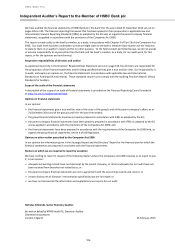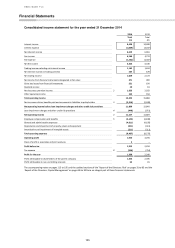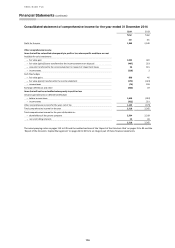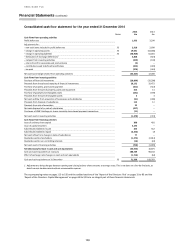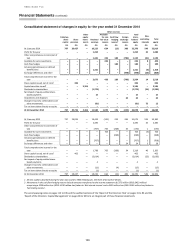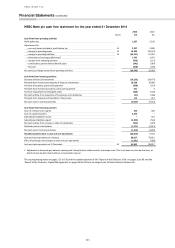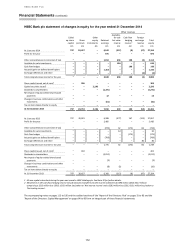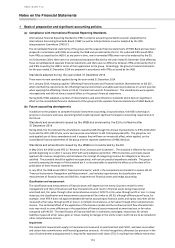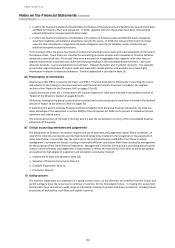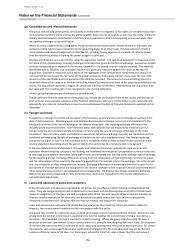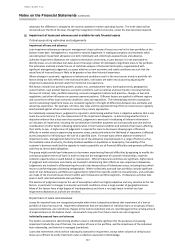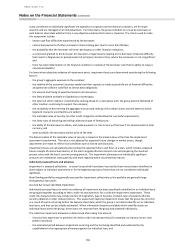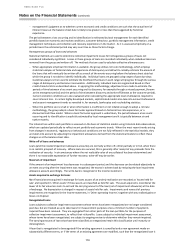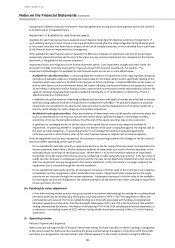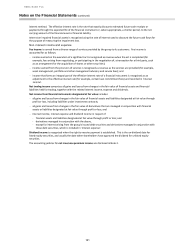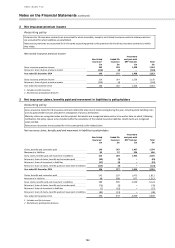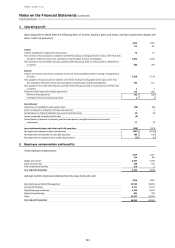HSBC 2014 Annual Report Download - page 115
Download and view the complete annual report
Please find page 115 of the 2014 HSBC annual report below. You can navigate through the pages in the report by either clicking on the pages listed below, or by using the keyword search tool below to find specific information within the annual report.
HSBC BANK PLC
Notes on the Financial Statements
113
1 Basis of preparation and significant accounting policies
(a) Compliance with International Financial Reporting Standards
International Financial Reporting Standards (‘IFRSs’) comprise accounting standards issued or adopted by the
International Accounting Standards Board (‘IASB’) as well as interpretations issued or adopted by the IFRS
Interpretations Committee (‘IFRS IC’).
The consolidated financial statements of the group and the separate financial statements of HSBC Bank plc have been
prepared in accordance with IFRSs as issued by the IASB and as endorsed by the EU. EU-endorsed IFRSs could differ
from IFRSs as issued by the IASB if, at any point in time, new or amended IFRSs were not to be endorsed by the EU.
At 31 December 2014, there were no unendorsed standards effective for the year ended 31 December 2014 affecting
these consolidated and separate financial statements and there was no difference between IFRSs endorsed by the EU
and IFRSs issued by the IASB in terms of their application to the group. Accordingly, the group’s financial statements
for the year ended 31 December 2014 are prepared in accordance with IFRSs as issued by the IASB.
Standards adopted during the year ended 31 December 2014
There were no new standards applied during the year ended 31 December 2014.
On 1 January 2014, the group applied ‘Offsetting Financial Assets and Financial Liabilities (Amendments to IAS 32)’,
which clarified the requirements for offsetting financial instruments and addressed inconsistencies in current practice
when applying the offsetting criteria in IAS 32 ‘Financial Instruments: Presentation’. The amendments were applied
retrospectively and did not have a material effect on the group’s financial statements.
During 2014, HSBC adopted a number of interpretations and amendments to standards which had an insignificant
effect on the consolidated financial statements of the group and the separate financial statements of HSBC Bank plc.
(b) Future accounting developments
In addition to the projects to complete financial instrument accounting, discussed below, the IASB is working on
projects on insurance and lease accounting which could represent significant changes to accounting requirements in
the future.
Standards and amendments issued by the IASB and endorsed by the EU but effective after
31 December 2014
During 2014, the EU endorsed the amendments issued by IASB through the Annual Improvements to IFRSs 2010-2012
Cycle and the 2011-2013 Cycle, and a narrow-scope amendment to IAS 19 Employee Benefits. The group has not
early applied any of these amendments and it expects they will have an immaterial effect, when applied, on the
consolidated financial statements of the group and the separate statements of HSBC Bank plc.
Standards and amendments issued by the IASB but not endorsed by the EU
In May 2014, the IASB issued IFRS 15 ‘Revenue from Contracts with Customers’. The standard is effective for annual
periods beginning on or after 1 January 2017 with early adoption permitted. IFRS 15 provides a principles-based
approach for revenue recognition, and introduces the concept of recognising revenue for obligations as they are
satisfied. The standard should be applied retrospectively, with certain practical expedients available. The group is
currently assessing the impact of this standard but it is not practicable to quantify the effect as at the date of the
publication of these financial statements.
In July 2014, the IASB issued IFRS 9 ‘Financial Instruments’, which is the comprehensive standard to replace IAS 39
‘Financial Instruments: Recognition and Measurement’, and includes requirements for classification and
measurement of financial assets and liabilities, impairment of financial assets and hedge accounting.
Classification and measurement
The classification and measurement of financial assets will depend on the entity’s business model for their
management and their contractual cash flow characteristics and result in financial assets being measured at
amortised cost, fair value through other comprehensive income (‘FVOCI’) or fair value through profit or loss. In many
instances, the classification and measurement outcomes will be similar to IAS 39, although differences will arise, for
example, since IFRS 9 does not apply embedded derivative accounting to financial assets and equity securities will be
measured at fair value through profit or loss or, in limited circumstances, at fair value through other comprehensive
income. The combined effect of the application of the business model and the contractual cash flow characteristics
tests may result in some differences in the population of financial assets measured at amortised cost or fair value
compared with IAS 39. The classification of financial liabilities is essentially unchanged, except that, for certain
liabilities measured at fair value, gains or losses relating to changes in the entity’s own credit risk are to be included in
other comprehensive income.
Impairment
The impairment requirements apply to financial assets measured at amortised cost and FVOCI, and lease receivables
and certain loan commitments and financial guarantee contracts. At initial recognition, allowance (or provision in the
case of commitments and guarantees) is required for expected credit losses (‘ECL’) resulting from default events that



